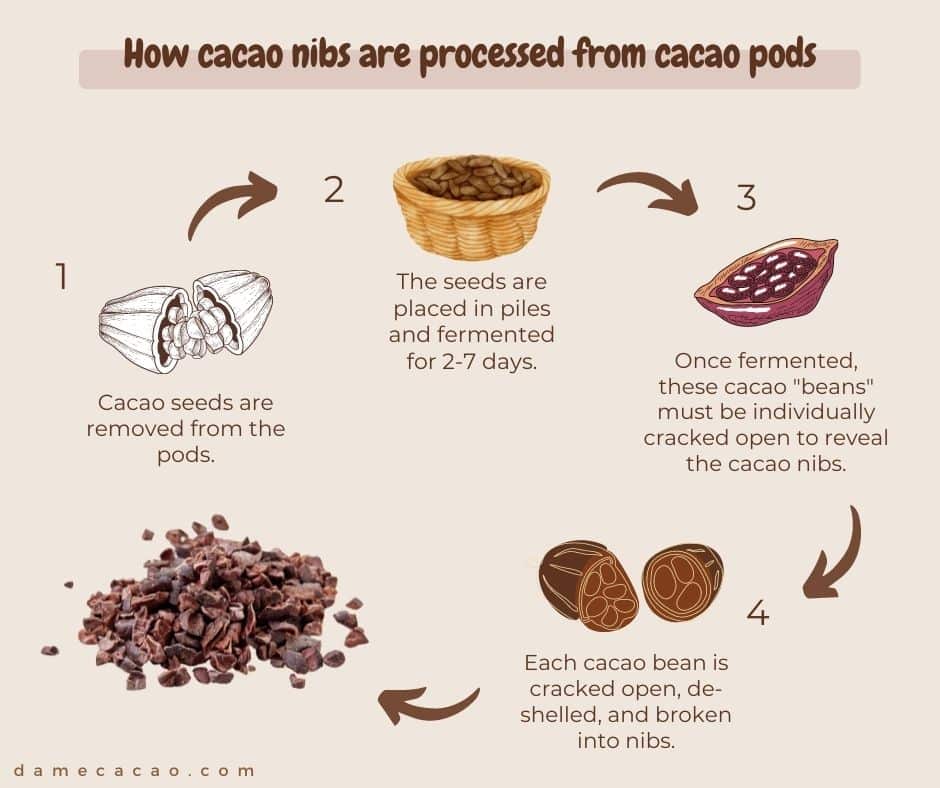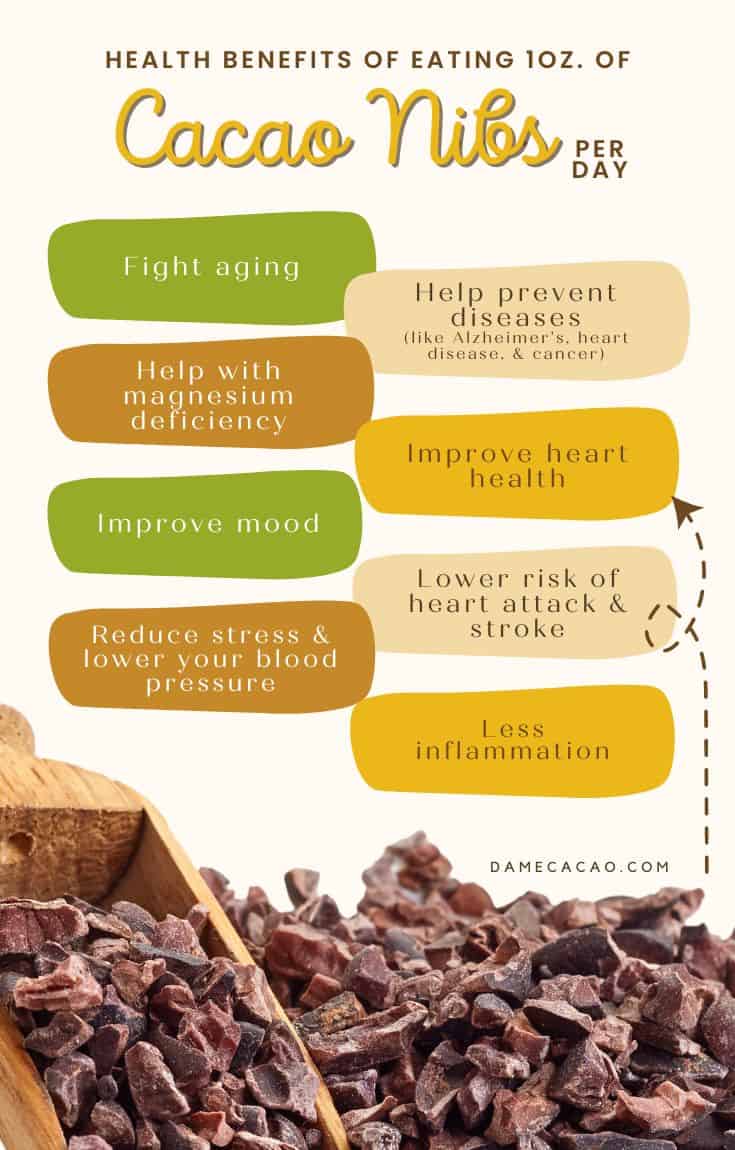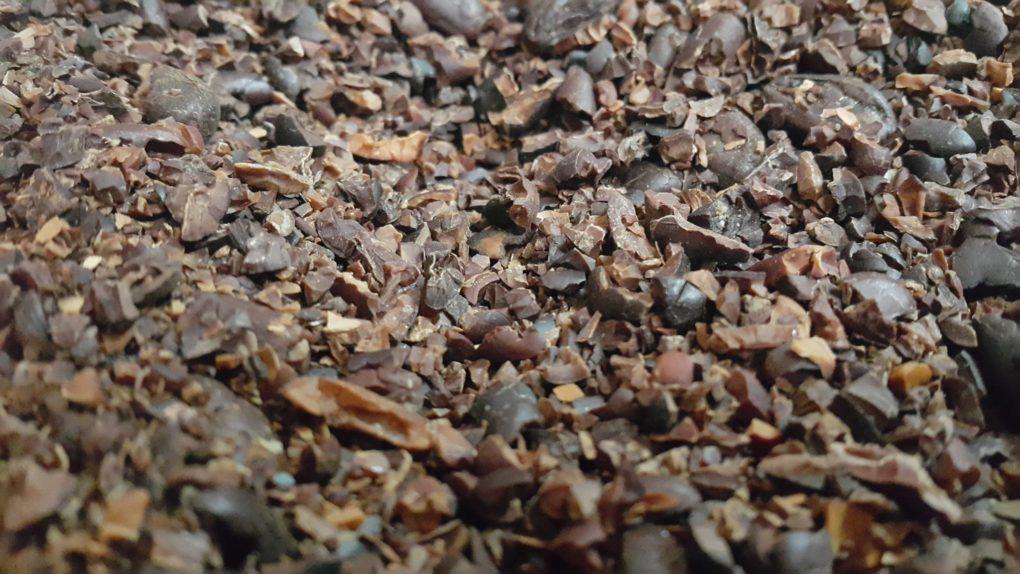You've almost certainly seen cacao nibs on the shelf at your local market, and you probably understand that they have some connection to chocolate. But a cocoa nib doesn't appear to have much in common with a chocolate bar at the supermarket, so it makes you wonder where the connection is.
Yet the relationship is very real, because those cocoa nibs actually become chocolate, with the addition of some sugar and maybe milk. This is because cacao nibs are just crushed cocoa beans, which are the only ingredient in chocolate from a legal standpoint.
Whether you call it baking chocolate or cacao paste or cacao nibs, it's all the same in the eyes of the law. So why has the idea of raw cacao nibs as a superfood taken so long to catch on?
Over the last few years, so many people have run out to try nibs for themselves, expected them to taste just like chocolate, and then tossed them because they don't. So what are cacao nibs, and how can you use their many health benefits to your advantage? In this article we dig into exactly that, plus how to know if you're buying quality nibs.

Jump To
What Are Cacao Nibs?
Cacao nibs are pieces of cacao beans, the material from which chocolate is made. These beans are in reality the seeds of the Theobroma cacao tree, a tropical plant native to South America, whose fruits grow directly on the trunk and branches of the tree. Each pod contains a few dozen seeds, and their outsides change color when ripe.
If you were to break open a cacao pod straight from the tree, you'd see a thick white pulp surrounding the seeds, all of which would be a vivid purple when cut in half. This purple color comes from the high levels of antioxidants in these unfermented seeds, but it also makes them very bitter and quite unpalatable.
Before they can be turned into cacao nibs, the seeds are removed from the pods and placed in piles, where they're left to ferment for 2-6 days.

This fermentation not only develops the rich, fudgy flavor we associate with chocolate, but it kills the germs— the part of each seed that would develop into the root system— so that it doesn't make each seed even more bitter.
Once fermented, these cacao "beans" (as they're now called) must be dried, packaged, shipped, cleaned, roasted, and individually cracked open in order to reveal the pieces of the cacao bean.
If you carefully peel a cocoa bean without breaking it, you can look closely and see how it's already naturally predisposed to break into small pieces. This natural map of cracks would have eventually developed into the branches of a cacao tree and the leaves & fruits it would produce.
Think of it like this: nibs are the espresso beans of the chocolate world, in that they're a potent crunch of the flavor you know & love— but they tend to be too strong for the casual consumer.

Cacao Nibs. Vs. Chocolate
Cacao nibs taste like a nuttier, richer, earthier, and often much more bitter version of dark chocolate. There's none of the milk or sugar we enjoy in chocolate to make cocoa nibs taste more smooth and balanced, so they hit your tongue more harshly.
Many companies these days are also just sourcing cacao from a large supplier, checking a box to order organic or not, and then repackaging the nibs with their own logo. Technically you are getting what you paid for, but low quality cacao nibs can taste overwhelmingly bitter, acidic, and flat, lacking the complexity of a high quality nib.
Cacao nibs are different from chocolate in more than just the sugar and dairy departments, however. When grinding cacao nibs into chocolate, over the first several hours they release a number of volatile acids that were formed during the fermentation process.
These acids contributed greatly to the cacao's flavor, but if they're not allowed to escape, they can make the chocolate taste very sour or acidic. Cacao nibs still contain these volatile flavor components, contributing to their overall much stronger flavor relative to chocolate, even a 100% chocolate.

Health Benefits of Cacao Nibs
The nutritional benefits of cacao nibs could and indeed has filled numerous books. Overall, cacao is good for you because it's high in dietary fiber, heart-healthy fats, antioxidants, and numerous trace nutrients. More specifically, cacao naturally contains a class of plant-derived antioxidants called flavonoids.
Flavanols and cocoa polyphenols are two types of flavonoid found in chocolate— as well as red wine and green tea— which fight aging at a cellular level. The main type of cocoa flavanol is called epicatechin, an antioxidant now commonly used as a supplement in bodybuilding, as it increases blood flow to the muscles and can even lower blood pressure.
Raw cacao nibs may contain more antioxidants, but if they're truly a "raw" food (unroasted & unfermented), they'll taste even more bitter and less like chocolate than their roasted counterparts. Truly raw cacao nibs taste like acidic dirt.

Dozens of tries of different cacao varietals has taught me that this is a universal truth (at the moment), and I just don't believe that healthy foods should taste bad. Chocolate products such as unsweetened dark chocolate also contain trace minerals which your body needs to function, such as calcium, magnesium, and phosphorus.
Note that these nutrients & antioxidants are found in the cocoa solids and not in cocoa butter, so neither blonde, ruby, nor white chocolate would have this benefit. But don't discount the butter-based chocolates quite yet, as cocoa butter is not bad for you in moderation.
In fact, cocoa butter is mostly made up of four types of fatty acids whose combined power has been shown to have an overall neutral effect on the heart.

What to Do with Cocoa Nibs
There are dozens of uses for cacao nibs, but how you choose to consume them is up to you. Organic cacao nibs are usually the best choice in the supermarket, but if you can buy cacao nibs or even whole cocoa beans from a local chocolate maker, the quality is usually better.
While you can use cacao nibs to make chocolate, your kitchen blender is unlikely to get you even close to the smooth texture you'd associate with chocolate, which refines for an average of 48 hours.
There are much better uses for cacao nibs, such as replacing a portion of the nuts or chocolate chips in some recipes, though each recipe needs to be tweaked individually. Unlike cocoa powder, cocoa nibs still contain roughly half fat (in the form of cacao butter).
So they add much more heft to foods like smoothies or ice cream, as well as more nutrient-dense calories. They can be added to baked goods or trail mix for the chocolate flavor you crave, but with a bit more dietary fiber and almost no impact upon blood sugar.
Figuring out how to add cocoa nibs to your diet can be as simple as figuring out how you best enjoy them. If you tend to prefer sweeter chocolates, you'll probably want to pair them with fruits in a chocolate smoothie or crush them to make homemade chocolate boba.
But if you're like me and you enjoy the bitter complexity, you can just eat them by the handful with raw almonds or pecans, as a midday snack or on top of your favorite yogurt for a crunchy texture.

Cacao Nibs FAQ
Cacao nibs taste earthy, somewhat acidic, deeply "chocolaty," and generally quite bitter. But whether cacao nibs taste good depends on your sensitivity to bitterness and the quality of the cacao, with higher quality nibs usually being less bitter and acidic.
Cacao nibs are a less processed but markedly less sweet version of dark chocolate. Because they contain no sugar, which both sweetens and softens the impact of cacao's flavor, cocoa nibs will taste sharper and probably less appetizing than their enticing aroma might suggest.
No. You cannot melt cacao nibs because the structural distribution of fats and solids is such that the solids would begin to burn before the fat could ever melt, and the nibs would just slowly smolder into a pile of ash.
Cacao is pronounced kah-kow.
Cocoa is pronounced koh-koh, totally silencing the 'a' at the end.
Cacao nibs have been connected to cancer because of recent studies on cadmium in chocolate. But acute cadmium levels in chocolate are not of concern— unless you have some condition which causes you to retain every single molecule of it to ever pass through your body, you won't get cancer from chocolate consumption. For one thing, you're exposed to much higher levels of cadmium in tobacco if you're a smoker, or in everyday foods grown in cadmium-rich soil, such as rice or legumes. On a more scientific note, just last month I had a "provoked" specimen test that chelated any heavy metals that have been stored in my body over the years. The test then expelled them to test their stored levels in my body; I have just .38ug/g of cadmium, well under the 1.5ug/g upper limit after eating lots of high percentage dark chocolate every day for over a decade.

















Peggy
Can cacao nibs be ground to brew like coffee?
Max
Yes, but you won't get nearly the depth and strength of flavor as you would with coffee, due to the fat content. You can also use the cacao bean husks for a more tea-like brew.
John Sampson
Effective way of breaking teeth.
Max
Lol definitely the way some companies roast them!